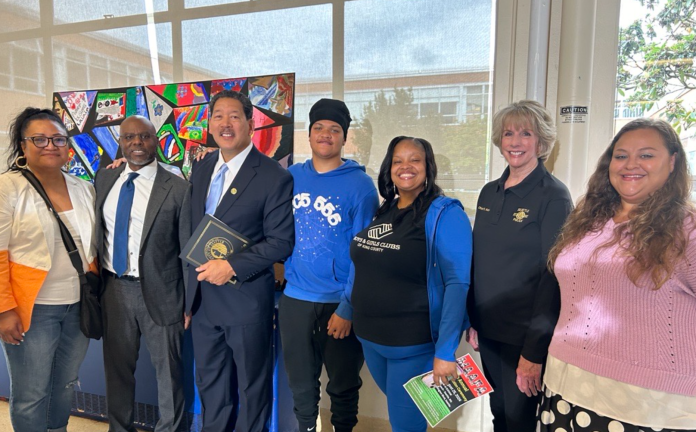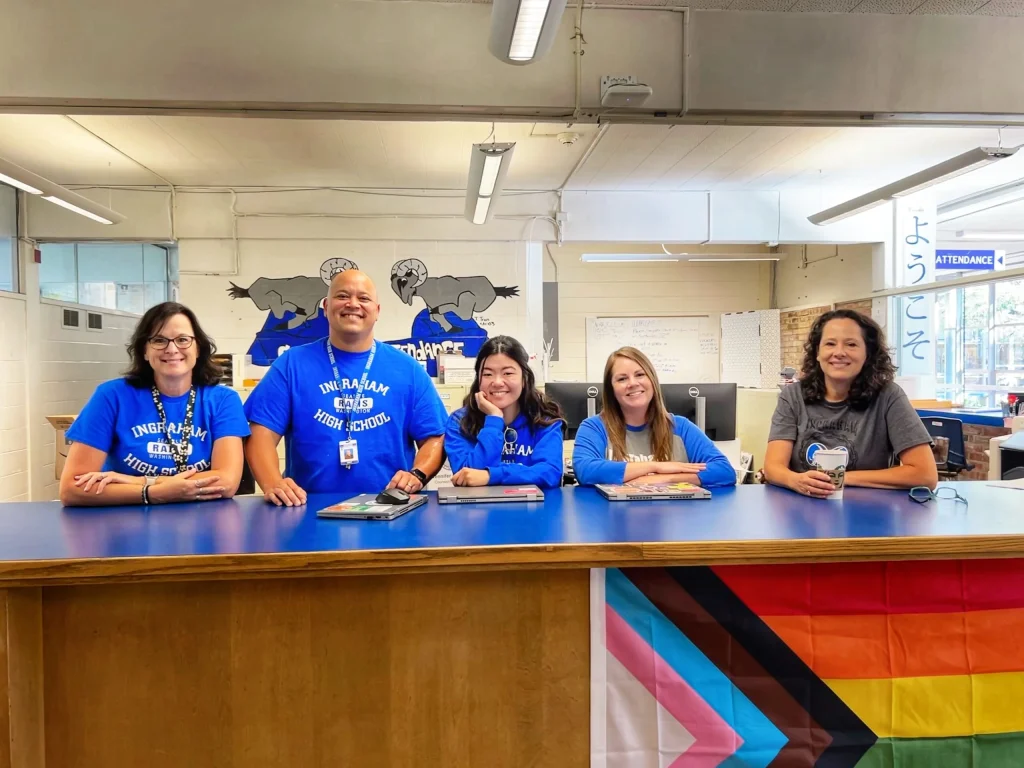
City and school officials promise a tangible change in safety and student supports when the new school year begins.
Seattle Public Schools (SPS) and City leaders have announced safety plans that will be in place when students return to classes on September 4.
Mayor Bruce Harrell presented a three-fold strategy to increase safety in Seattle’s schools: school-based mental health services, violence interruption programs, and Seattle Police Department (SPD) law enforcement. This plan comes with a $14.55 million investment, $12.25 million from the City of Seattle and $2.3 million from SPS.
Focused interventions will be tried at five high schools and six middle schools with the highest rates of violence, including Garfield and Ingraham, both of which have experienced tragic shootings in recent years.
“The young people are the true measure of a community’s health,” Harrell said.
The City will allocate $5.6 million for additional school-based mental health counselors and a health coordinator totaling 42 new positions, $2.4 million for telehealth therapy services, and the remaining $4.25 million for violence interruption programs in partnership with community-based organizations This will include safe passage programs, new violence intervention specialists working directly out of focus schools, and individual case management for those students most likely to experience gun violence.
The City is also establishing a new family resource fund to support students and families at the highest risk of gun violence. This fund will offer assistance for basic needs, such as clothing, food, utilities, and transportation. Its total size has not yet been determined.
SPS’s $2.3 million will be spent increasing staffing on the safety and security team, including hiring an executive director of student and community safety and school infrastructure, such as cameras, perimeter fencing and gate improvements, and classroom door lock enhancements.
“We have a 33% increase [in security specialists]. You can see almost 15 new security personnel at our schools, so that is one thing that’s tangible,” Superintendent Brent Jones said. “Parents and families will see something different at Garfield on day 1.”
The 2024-2025 SPS budget also includes more money for social workers, raising the total to more than 50.
As for the police enforcement piece, Interim Chief Sue Rahr said, “The police will be around the school. We’ll be as visible as we possibly can, for the purposes of just letting people know we are here to keep you safe.”
SPD will remain outside the schools, instead of being brought back inside in the capacity of student resource officers. However, Rahr spoke at some length about the importance of SPD building trusting relationships with the school and community, which may hint at SPD’s desire to return to school enforcement in the future.
“Police are not best equipped or trained to reduce harm in schools,” said Oliver Miska, a SPS substitute teacher and director of Solidarity Policy and Public Affairs. “We must invest in police alternatives to safety. Teachers must also be given alternatives to calling the police to keep their classrooms safe.”
Unaddressed is how SPD will increase its presence around schools given its current staffing shortage difficulties. In June, SPD announced that in 2024 it will once again lose more officers than it can hire, which has been a major trend locally since 2020, mirrored in national trends.
For now, SPS will utilize its expanded security team and more violence interrupters to address students’ safety in school.
“If what we’re trying to solve for is having violence prevention and a sense of security and present[ing] a physical presence in the school, can we achieve those things without introducing some of the perceived harms that community members have with law enforcement? I think the answer is yes,” King County Councilmember Girmay Zahilay told The Urbanist in an interview last month.
“I think there are ways of getting first responders and security staff who have strong relationships in the community, come from the community, have training and mental health resources and violence de-escalation, and can mitigate or minimize the downside,” Zahilay continued.
The SPS school board will be meeting on Wednesday, August 28 for the last time before the new school year begins. No safety items are currently on the agenda, although Jones may address safety and wellness measures during his comments.
A question of funding

When asked how the city decided on a funding level of $14.55 million, Harrell said it was arrived at by “talking to communities, looking at our budget, talking to everyone we could.”
However, the full $12.25 million investment being provided by the city was actually made possible by last year’s city council, who made a small increase to the JumpStart payroll tax during last year’s budget deliberations to raise $20 million for student mental health. This investment narrowly passed a budget committee vote, with Councilmember Tammy Morales voting in favor and Councilmembers Sara Nelson and Dan Strauss voting against. While those three councilmembers are back this year, the other six councilmembers in last year’s vote have since left, whether through retirements, winning higher office, or losing reelection.
Without this small increase to progressive revenue, it is uncertain whether these new investments for student safety and mental health would have been possible for this school year.
Even so, in the mid-year supplemental budget, Harrell sought only $10 million of the total $20 million available to increase student mental health supports and gun violence prevention programs.
When the supplemental budget was brought before the city council earlier this summer, Morales tried on two separate occasions to add amendments that would authorize spending the full $20 million amount.
“This council has an opportunity to address the root cause of violence in our communities with this investment. I am bringing this back because we’ve heard overwhelmingly that the solutions that young people need are safe third spaces and mental health services with trauma-informed response to address gun violence,” Morales said before the final amendment vote.
“We have fully funded SPD, and now we must fully fund this mental health work,” Morales continued. “This amendment is coming clearly from community and is for community. It would restore the entire 20 million to be spent on expanding education supports, including mental health and student safety restorative practices, and investments in safe spaces and activities.”
Other councilmembers seemed less enthusiastic about the previous council’s work in this area.
“My understanding is last year, when the council put the 20 million into the budget, it did not give guidance or get guidance from mental health professionals, or did any research into how to deliver this mental health support effectively,” Councilmember Maritza Rivera said. “Just as concerning, they did not provide a sort of funding model because they didn’t do the research. And then my further understanding is that the actual figure of 20 was an arbitrary figure that was not actually rooted in anything the city was currently doing.”
“There was no plan, there was no research, there was seemingly no rational basis for arriving at the investment amount, but an investment amount and commitment was made, and here we are,” said Councilmember Rob Saka.
“One of the things that [Councilmember Rivera’s] rundown highlights was the lack of good governance by the old council,” Councilmember Bob Kettle said. “Absolute lack of good governance by the old council, lack of coordination, lack of anything really, and that’s an issue here.”
The original ask of $20 million for student mental health last fall came directly from Seattle’s students.
None of the councilmembers’ criticisms acknowledged that the action of the former council was what made it possible for the City to make tangible investments to address the crises around mental health crisis and gun violence that Seattle youth face. Nor did they acknowledge the Black Lives Matter (BLM) movement that laid the groundwork for those investments.
The second time it was introduced, the council defeated Morales’s amendment by a narrow margin, with Councilmembers Morales, Hollingsworth, Saka, and Woo voting in favor and Councilmembers Kettle, Moore, Nelson, Strauss and Rivera voting against.
“The city is defunding mental health, restorative justice, and violence prevention strategies, while wrongfully doubling down their investment in police as the first responder to crisis in our schools,” Miska said in response to the vote. “It feels like the city isn’t doing enough to center youth and educators in the solution discussion when alternatives have been called for since before 2017 with BLM at school demands.”
After the defeat of Morales’s amendment, Strauss brought forward an alternative amendment before the council that increased the student mental health funding from $10 million to $12.25 million.
“I believe we have the ability to implement the programming and get the funding out the door at the 2.25 additional million dollar level,” Strauss said. “I don’t have that confidence with the ability to implement the programming and get the funding out the door at the additional 10 million level.”
Strauss’s amendment passed unanimously and is the reason the total funding level for school safety now sits at $14.55 million instead of $12.3 million.
Currently in question is what level of investment for student safety and mental health Harrell will include in his proposed 2025 budget, due at the end of September.
“When we look at what we’re prioritizing, this rises to one of the top,” Harrell said about the $12.3 million invested so far.
“We think it’s a good investment, and I made this clear: this is evolving work,” Harrell continued. “I may come back to you in six months and we may pivot. We may increase and expand.”
Against the backdrop of a $260 million budget deficit, whether Harrell will maintain last year’s $20 million investment in student mental health will speak loudly to what the current administration’s priorities truly are.
Amy Sundberg is the publisher of Notes from the Emerald City, a weekly newsletter on Seattle politics and policy with a particular focus on public safety, police accountability, and the criminal legal system. She also writes science fiction, fantasy, and horror novels. She is particularly fond of Seattle’s parks, where she can often be found walking her little dog.

